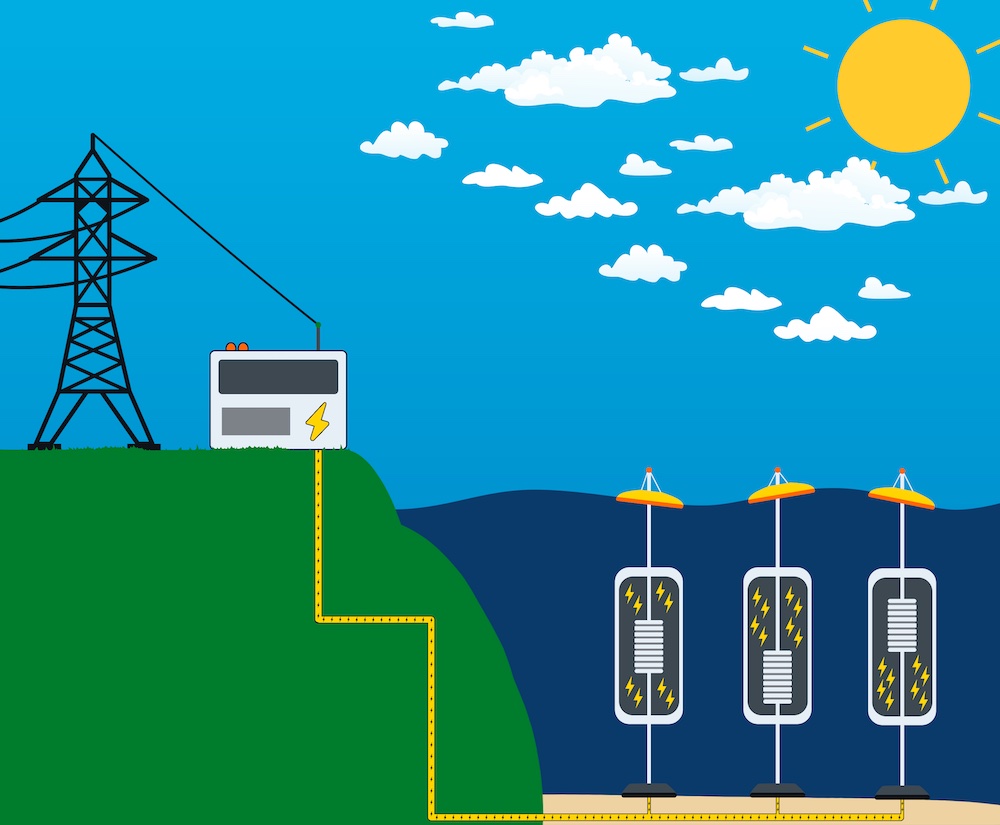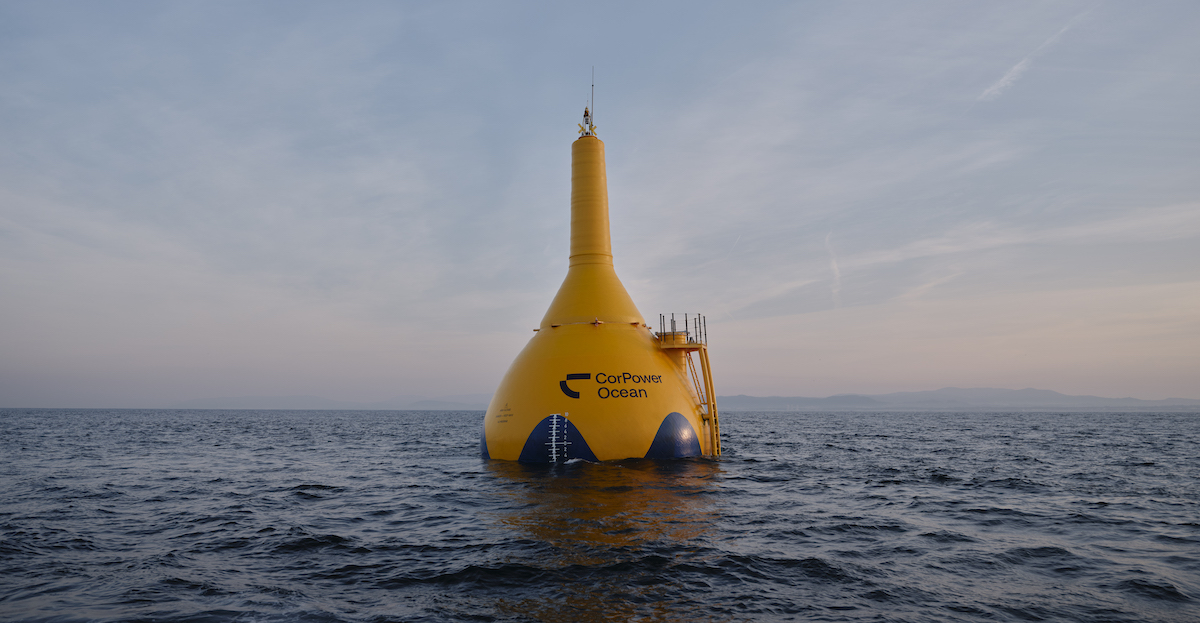Updated 3 months ago
Wave Energy Pros and Cons
Written by Ana Almerini Ana AlmeriniAna is the Marketing & Communications Manager at SolarReviews, working within the solar industry since 2020. With a Master's in Climate and Society an...Learn more

Why you can trust SolarReviews
SolarReviews is the leading American website for solar panel reviews and solar panel installation companies. Our industry experts have a combined three decades of solar experience and maintain editorial independence for their reviews. No company can pay to alter the reviews or review scores shown on our site. Learn more about SolarReviews and how we make money.
Ocean waves exert tremendous amounts of power, which can be utilized as a renewable resource known as wave energy, or tidal energy.
The United States has the potential to generate 2.64 trillion kilowatt-hours of ocean energy - or 63% of the total utility-scale electricity generation in 2023
If we had the potential to generate more than half of the U.S. electricity from waves, what is hampering the utilization of wave energy?
In this article, we will take a deeper look at the pros and cons of wave energy and what makes wave energy power plants challenging to implement.
Key takeaways
Wave energy, which is energy captured from ocean waves by buoys, is not yet available at a scale large enough to be a legitimate power source.
Wave energy creates power from the force of naturally-occurring waves in the ocean to propel turbines, while hydropower plants create energy using the force of water that rushes through a dam.
Wave energy has huge global potential and can be extremely reliable because waves generate power 24/7.
Building and maintaining wave energy plants will be expensive but they can be an important addition to the renewable energy mix.
Pros and cons of wave energy
Pros of wave energy | Cons of wave energy |
|---|---|
Zero emissions | Environmental effects |
Renewable | High costs |
Energy potential | Scalability |
Reliable |
What is wave energy?
The easiest way to think about it is this: a wave’s force powers underwater turbines that are attached to a buoy. The turbines then spin from the force of water and generate electricity.
Wave energy produces electricity using naturally occurring forces of water within the ocean. Waves are incredibly powerful and wave energy plants harness this power by utilizing the steps within the infographic below.

The buoys at the bottom right serve as a water intake system. The water then rushes up to a generator equipped with turbines, or wave energy converters (WEC), that spin when moving water hits them. The movement of the WECs is what generates electricity. This electricity is then sent to the grid via power lines.
Hydropower, on the other hand, uses the flow of moving water to directly push a turbine that is connected to a generator and creates electricity. In fact, the only thing that wave energy and hydropower share is the fact that they are both powered by the forces of water.
Learn more: Hydropower pros and cons
Wave energy has huge potential but it is very challenging to harness because of the nature of seawater - it is corrosive and its movements change often.
However, currently there aren’t any large-scale wave energy plants in use. There are only very small ones, which are mostly being used for research on how to best capture wave energy.
Advantages of wave energy
1. Zero emissions
Inherently, wave energy does not emit greenhouse gasses when generated, like fossil fuels do.
Turbines generate electricity through the power of waves, making them a completely pollution-free, renewable energy source.
If we can get the technology right, tidal power can be a huge part of the green energy mix, complementing solar power, wind turbines, geothermal, and hydropower.
2. Renewable
Like other alternative energy sources, wave power is renewable.
Waves are created by wind, and wind is caused by uneven heat on the planet's surface driven mostly by the sun warming different locations at different rates.
Wind moves heat energy from one part of the planet to another, which causes waves to form. Because wind will always exist, waves will always be available at the surface of the water to generate electricity, making this a renewable source.
3. Enormous energy potential
The amount of kinetic energy that is exerted in a wave is huge - that energy then gets captured by wave energy converters to produce electricity.
For example, an average 4-foot, 10-second wave can put out 35,000 horsepower per mile of coast. The ocean provides a lot of potential for energy production because it is constantly moving and generating energy.
There is also a lot of potential because many countries have access to an ocean that can help power their electric grids.
4. Reliable energy source
Waves are hardly interrupted and almost always in motion. This makes electricity generation from wave energy a more reliable energy source compared to wind power, since wind is not constantly blowing.
It should be noted that the amount of energy that is being transported through waves does vary every year, and from season to season. Generally, waves are more active in the winter because of the increased wind, which is due to colder temperatures.
Disadvantages of wave energy
1. Environmental effects
Because wave energy is still in its infancy, mostly in research, there is no measure of the environmental effects of large-scale power stations on the shore.
Building plants or electrical wires directly on the beach might prove challenging because they would be unsightly and can cause damage to marine life and the surrounding ecosystems.
Local fishing zones could be affected or the plants could lead to more coastal corrosion. However, more research is needed to determine the true environmental impacts that wave energy plants could cause.
2. High costs
Wave power is an emerging energy technology in the early stages of development, making speculating on costs difficult.
Wave energy systems have the potential to be as cheap as $0.075 cents per kWh to build, but will depend on location and maintenance costs. However, at the moment, the costs of wave power are generally very high because they are in the research phase of development and generally paid for by government grants or research grants. There are no energy companies utilizing wave energy at scale - something which would bring the cost down.
Maintenance for these plants is projected to be very expensive because they will be submerged in constantly-moving saltwater. Because constant movement can lead to more breaking, wave energy plants will most likely need regular (and costly) maintenance.
3. Hard to scale
Perhaps the biggest con at the moment is that no utility has the ability to install wave farms because they are not yet large enough to provide a significant amount of electricity.
While some wave energy systems have been tested in Scotland, Hawaii, and most recently, Australia, their power generation capacity is only about 2.5MW at their peak. The industry is expected to grow, but it remains challenging to implement wave energy generators at a usable scale.
The future of wave energy
For many ocean-bordering countries, wave energy could be a great addition to the renewable energy mix.
Waves would provide 24/7 energy that could be harnessed for clean electricity generation. Because wave energy is still in its early stages, it remains expensive to install and the potential environmental disadvantages are not yet fully known.
The bottom line is that wave power has enormous global potential. However, the industry needs more funding and research to finalize the technology involved so that countries and utilities can begin adding wave energy to their renewable energy arsenal.
Curious about other energy sources?
Here are our helpful guides to other energy sources:
- Geothermal energy pros and cons
- Biomass energy pros and cons
- Fossil fuels pros and cons
- Tidal energy pros and cons
- Nuclear energy pros and cons
- Non-renewable energy sources
Ana is the Marketing & Communications Manager at SolarReviews, working within the solar industry since 2020. With a Master's in Climate and Society and professional experience in marketing, she helps communicate the value of solar to homeowners and build awareness of the SolarReviews brand. On weekends you can find her at the Jersey shore, reading a book from the ever-increasing stack on her side table, or eating food someone else cooked....
Learn more about Ana Almerini